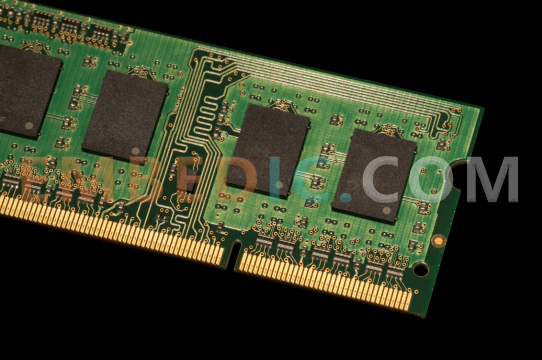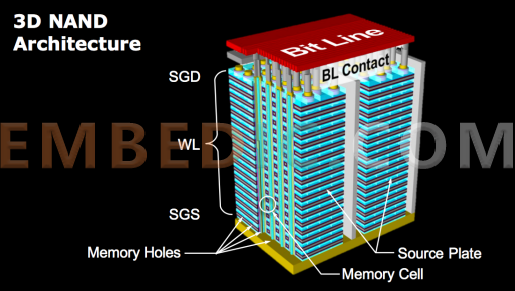DRAM stands for Dynamic Random Access Memory. It's a type of volatile memory used in computers and other electronic devices for storing data and serving as the main memory during the operation of a system.

DRAM is characterized by its ability to store data in a cell consisting of a capacitor and a transistor. Unlike static RAM (SRAM), which uses a flip-flop to store each bit of data, DRAM requires periodic refresh cycles to maintain the stored information. This refresh process is necessary because the electrical charge in the capacitors slowly leaks away over time.
Due to its structure and need for refreshing, DRAM is generally slower than SRAM but offers higher storage densities at a more affordable cost. It is commonly used as the primary memory in computers and plays a crucial role in providing quick access to data that the CPU needs during its operations.
NAND is a type of flash memory technology used in storage devices like USB drives, solid-state drives (SSDs), memory cards, and other similar devices. It's called NAND because it's built using a logic gate called the NAND gate.

NAND flash memory is non-volatile, meaning it retains data even when the power is turned off. It's known for its ability to store data electrically, making it ideal for a wide range of applications that require persistent storage.
NAND flash memory works by storing information in a grid of memory cells. These cells are organized in a way that allows data to be written and read in large blocks, making it suitable for high-capacity storage devices. NAND flash memory cells can store multiple bits of data, typically ranging from one bit per cell (single-level cell or SLC) to more bits per cell (multi-level cell or MLC, triple-level cell or TLC, quad-level cell or QLC), which affects the storage capacity and performance of the memory.
NAND flash memory is widely used in various electronic devices due to its speed, durability, and capacity. However, compared to other types of memory like DRAM, NAND flash memory tends to be slower for both reading and writing operations.
DRAM and NAND are two different types of memories; DRAM (Dynamic Random Access Memory) is a type of random access memory and NAND (Not AND) is a type of logic gate. Although they are both used to store data, there are many differences in construction, function, performance and application.
First, DRAM and NAND are constructed differently.DRAM is composed of individual memory cells, each consisting of a capacitor and a switch. When reading and writing data, DRAM needs to refresh the capacitor periodically to keep the data stable. NAND is an electronic component based on non-gate logic design, which consists of a series of logic gates connected together to realize the storage and reading of data by controlling the on-off of the logic gates.
Secondly, DRAM and NAND work differently. DRAM stores data by keeping charge in a capacitor. When data needs to be read, DRAM reads the charge in the capacitor through a transmission line to the circuit for processing. When writing data, the charge is transferred into the capacitor and charged or discharged depending on the input signal. NAND, on the other hand, stores and reads data through non-gate logic. When writing data, NAND uses the input signal to control the state of the logic gate, storing data in the charge in the logic gate. When reading data, the output signal of the logic gate indicates the data stored in it.
DRAM and NAND also differ in terms of performance. read and write speeds of DRAM are usually very fast because it reads and writes data through charge transfer. On the other hand, NAND has relatively slow read and write speeds because it requires input and output signals from logic gates for data storage and reading.
Moreover, DRAM and NAND differ in terms of reliability of data storage.DRAM requires periodic refreshing of capacitance to keep the data stable otherwise it leads to loss of data in time. NAND, on the other hand, has better data persistence because it stores the state of charge in the logic gates rather than the charge temporarily stored in the capacitors. In addition, NAND enhances data reliability through error detection and correction codes (ECC).
In addition, DRAM and NAND differ in their applications. Due to DRAM's fast read and write characteristics, it is commonly used in computer memory for real-time operations and temporary storage. NAND, on the other hand, has a slower read/write speed but has a larger storage capacity, so it is commonly used in storage media such as flash memory, SSDs, and memory cards for mobile devices.
To summarize, DRAM and NAND are different in terms of construction, operating principle, performance, reliability and application. DRAM has fast read/write speed and high performance, and is widely used in computer memory. NAND, on the other hand, has a larger storage capacity and better data persistence, and is widely used in storage media. These differences make DRAM and NAND have their own application advantages in different fields.
Manufacturer: Texas Instruments
IC DGTL MEDIA PROCESSOR 529FCBGA
Product Categories: DSP
Lifecycle:
RoHS:
Manufacturer: Microchip
IC MCU 16BIT 16KB FLASH 20SOIC
Product Categories: 16bit MCU
Lifecycle:
RoHS:
Manufacturer: Texas Instruments
IC DGTL MEDIA PROCESSR 1031FCBGA
Product Categories: DSP
Lifecycle:
RoHS:
Manufacturer: Texas Instruments
IC DSP ARM SOC BGA
Product Categories: SOC
Lifecycle:
RoHS:
Looking forward to your comment
Comment